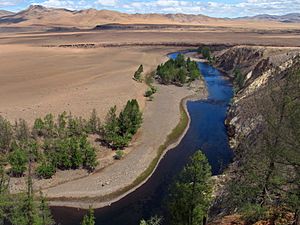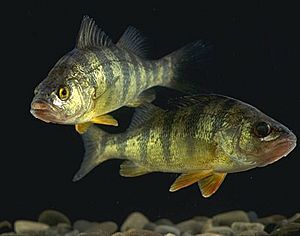Wildlife of Mongolia facts for kids
The wildlife of Mongolia is amazing! It includes all the plants, animals, and fungi that live in this unique country. Mongolia has many different types of land, from salty marshes and freshwater lakes in the north to dry desert steppes in the middle. In the south, you'll find semi-deserts and the hot Gobi desert, which is the fifth largest desert in the world.
About 90% of Mongolia is covered by deserts or grasslands. This means the weather can be very extreme. Even with these tough conditions, Mongolia is home to a huge variety of animals. There are 139 different types of mammals, like wild camels and snow leopards. You can also find 448 kinds of birds, with many traveling long distances to visit. Plus, there are 76 types of fish, 22 types of reptiles, and 6 types of amphibians.
Most of the country (55%) is covered by grasslands and shrublands. Forests cover only a small part, about 6% in the steppe areas. Desert plants cover 36% of the land. The eastern steppe region has the largest grassland in the world!
Contents
Mongolia's Landscape and Water
Where is Mongolia Located?
Mongolia is a country in Asia that doesn't have a coastline. It's surrounded by other countries like Tibet, Siberia, and Northeast China. Because of this, Mongolia's wildlife is a mix of species from all these neighboring areas. Most of the land is covered by grasslands, shrublands, and forests.
Mongolia's Rivers and Lakes
Mongolia's rivers and lakes are shaped by Asia's main water divide. This divide separates water that flows to the Arctic Ocean from water that flows to the Pacific Ocean. In the western and southern parts of Mongolia, rivers often flow into salty lakes that don't have outlets to the sea. These rivers might even dry up during certain seasons.
However, rivers in the northern part of the country flow all year round. The two most important river systems are the Orkhon River and the Selenge River. The Orkhon is Mongolia's longest river that stays completely within the country. It eventually joins the Selenge River.
Many of Mongolia's lakes are salty. But the biggest freshwater lake is Lake Khövsgöl. It's a natural lake formed in a deep valley. Lake Khövsgöl is the second oldest lake in the world! It holds 65% of all of Mongolia's fresh water, which is about 2% of the world's fresh water.
Mongolia's Climate and Weather
Mongolia has a continental climate. This means it has very cold winters and cool to hot summers, especially in the deserts. The weather can change a lot between winter and summer. In the northern part of the country, the temperature can vary by as much as 44°C (80°F) between seasons. Even in one day, the temperature can change by 30°C (55°F)!
For example, in Ulaanbaatar, the capital city, the average temperature in January is about -21°C (-7°F). In July, it's around 17°C (63°F). In the Gobi desert, January averages -15°C (5°F) and July averages -14°C (7°F).
Rainfall and Snow in Mongolia
Rain and snow are not spread evenly across Mongolia. It depends on how high the land is and how far north it is. Low desert areas in the south and west get less than 10 cm (4 inches) of rain each year. But northern mountain areas can get about 36 cm (14 inches). Ulaanbaatar usually gets about 25 cm (10 inches) of rain annually.
Mongolia is a very sunny country, with 220 to 260 clear days each year. However, fierce blizzards can happen in the mountains and grasslands. When a thin layer of snow covers the ground, it can make it impossible for animals to find food.
Protecting Mongolia's Wildlife
Laws to Protect Nature
People started to use Mongolia's natural resources more and more between the 1600s and 1900s. This meant new laws were needed to protect the environment. In 1995, Mongolia passed two important laws: the Mongolian Law on Environmental Protection and the Mongolian Law on Hunting.
For example, the grasslands where Mongolian gazelles live cover a huge area of 275,000 square kilometers. This is known as the "largest remaining example of a temperate grassland ecosystem" in the world.
Mongolia's Protected Areas
After Mongolia became independent in 1990, there was a big idea to make 100% of the country a national park! While that was a bit too ambitious, the goal was set to protect 30% of the land. However, because of the need to develop mines and other industries, about 13.8% of the country is currently protected. This covers an area of 215,200 square kilometers, with over 60 protected areas.
There are four main types of protected areas:
- Strictly Protected Areas: These are very fragile places where hunting, logging, and building are not allowed. People usually don't live here.
- National Parks: These areas are important for history and education. They allow for eco-tourism, and local nomads can sometimes fish or graze their animals in certain spots.
- Natural and Historic Monuments: These places have special natural or historical value, and building activities are limited.
- Nature Reserves: These areas protect rare and endangered plants and animals, and also have archaeological importance. Some development is allowed here, but only under strict rules.
Some of the most important strictly protected areas are part of the UNESCO Man and the Biosphere Programme. These include Bogd Khan Uul Biosphere Reserve, Great Gobi Reserve, Uvs Nuur Basin Reserve, Dornod Mongol Biosphere Reserve, and Khustain Nuuru Reserve.
Here are some other protected areas:
- Strictly Protected Areas
- Khasagt Khayrkhan
- Khukh Serkhiin Nuruu
- Khan Khentii Uul
- Otgon Tenger Reserve
- Numrug
- Mongol Daguur Biosphere Reserve
- National Parks
- Gobiin Gurvan Saykhan
- Khovsgul Nuur
- Khorgo Terkh Zagaan Nuur
- Gorkhi Terelj
- Altai Tavan Bogd National Park
- Tsambagarav Uul National Park
- Khustain Nuruu National Park
- Lake Khövsgöl National Park
- Southern Altai Gobi National Park
- National Reserves
- Ugtam Uul
- Lkhachinvandad Uul
- Bulgan Gol
- Sharga and Mankhan
- Khustain Nuruu
- Nagalkhan Uul
- Batkhan Uul
- Gun-Galuut Nature Reserve
- National Monuments
- Eej Khairkhan
- Bulgan Uul
- Togoo Tulga Uul
- Naiman Nuur
- Ganga Nuur
Plants of Mongolia (Flora)
Most of Mongolia's land (about three-fourths) is covered by grasslands. These grasslands are very important because they provide food for a lot of livestock like horses, sheep, and goats. The rest of the country has forests and dry deserts.
Mongolia has four main plant zones. In the northern areas, you'll find coniferous forests, like the taiga region. Higher up in the mountains, there's alpine tundra. In the mountain forest-steppe zone, plants grow thickly on the northern slopes. Here you'll see tall Siberian larches and Siberian cedars. There are also spruces, pines, and firs. Deciduous trees like white and brown birches, aspens, and poplars also grow here.
The wide river valleys and southern mountain slopes have steppe plants. Pasturelands are covered with grasses like feather grass and couch grass, along with wormwood and many types of fodder plants that animals eat.
In the semi-desert and Gobi desert areas, plants are scarce. But there's just enough for camels, sheep, and goats to survive. A special drought-tolerant plant called Saxaul grows here. It's used for firewood. Elms and poplars can also be found near springs and underground water. Saxaul shrubs help hold the sand dunes in place and stop erosion. These shrubs can grow up to 4 meters tall over 100 years.
You can also find beautiful Rhododendrons with red, yellow, and white flowers, and the famous edelweiss flower. Sadly, more than 200 plant species in Mongolia are currently at risk.
Animals of Mongolia (Fauna)
Mongolia is home to 139 different kinds of mammals and 448 kinds of birds.
Mammals of Mongolia

Mongolia has many large mammals. These include gray wolves and Siberian ibex. It also has some very rare and endangered animals. These include the wild Bactrian camel, the amazing snow leopard, and the Gobi bear. The Gobi bear is the rarest bear in the world and only lives in the Gobi desert.
Another special animal is the Przewalski's horse, also known as the takhi. These wild horses almost disappeared completely but have been brought back from horses raised in zoos. The Asiatic wild ass also lives in the Gobi desert, and Mongolia has the largest number of them in the world.
The saiga antelope used to be common, but its numbers have dropped a lot due to hunting and livestock grazing. The Mongolian saiga is now critically endangered, with fewer than 5,000 left.
Other mammals you might find are the argali sheep in the rocky mountains, the Siberian musk deer, and the Pallas's cat (also called manul). There are also black-tailed gazelles, stone martens, and wild cats in the Altai region. In the forest areas, you might see wild boars, red deer, and roe deer. In the forest and steppe edges, there are muskrats, red foxes, steppe foxes, and sables.
Organizations like the World Wildlife Fund and the Zoological Society of London are working hard to protect these animals. They focus on snow leopards, Altai argali sheep, saiga antelope, gazelles, Bactrian camels, long-eared jerboas, and Mongolian gerbils.
Birds of Mongolia
Mongolia is a birdwatcher's paradise! It has many large bird species. Six different types of cranes live in Mongolia, which is half of all the crane species in the world. There are 22 endangered bird species, including hawks, falcons, buzzards, cranes, and owls. Even though people don't hunt cranes because of old beliefs, their homes are being destroyed. Only about 5,000 breeding pairs of cranes are left, mostly in the Mongol Daguur Biosphere Reserve. The white naped crane is a critically endangered species in eastern Mongolia.
Overall, there are 469 bird species in Mongolia. About 330 of these birds migrate, meaning they travel to Mongolia for part of the year. The other 119 species live there all year round. Some of the birds you might see include the golden eagle, lammergeyer, spoonbills, Dalmatian pelican, great white egrets, whooper swans, great black-headed gulls, black storks, swan goose, and Altai snowcock.
Aquatic Life in Mongolia's Waters
Mongolia's rivers and lakes are home to 76 different kinds of fish. Some of these include trout, grayling, roach, lenok, Siberian sturgeon, pike, perch, and the Altai osman, which is only found in Mongolia.
One of the most impressive fish is the taimen. This huge fish is related to salmon and can grow up to 1.5 meters (5 feet) long and weigh 50 kilograms (110 pounds)!
Challenges and Conservation Efforts
After Mongolia became independent in 1990, its economy changed a lot. The country started to rely more on its wildlife and natural beauty to earn money. This led to some serious problems with over-using these resources. So, Mongolia decided to focus on eco-tourism. This way, people can visit and enjoy nature, and the money earned helps protect the country's amazing biodiversity.
Besides official efforts, there are other big threats to Mongolia's wildlife. These include illegal hunting of animals like musk deer, elk, boars, squirrels, and marmots for illegal trade. Too many livestock animals grazing also causes problems, as they need a lot of water. Climate change is another big challenge. Fires in the grasslands and forests also kill many animals. And very cold winters and droughts can make it hard for animals to survive.
To protect its rich biodiversity, the Mongolian government has created national parks and nature reserves. They also have laws about hunting and fishing, both for sport and for commercial purposes. These efforts help ensure that Mongolia's unique wildlife can continue to thrive for future generations.











